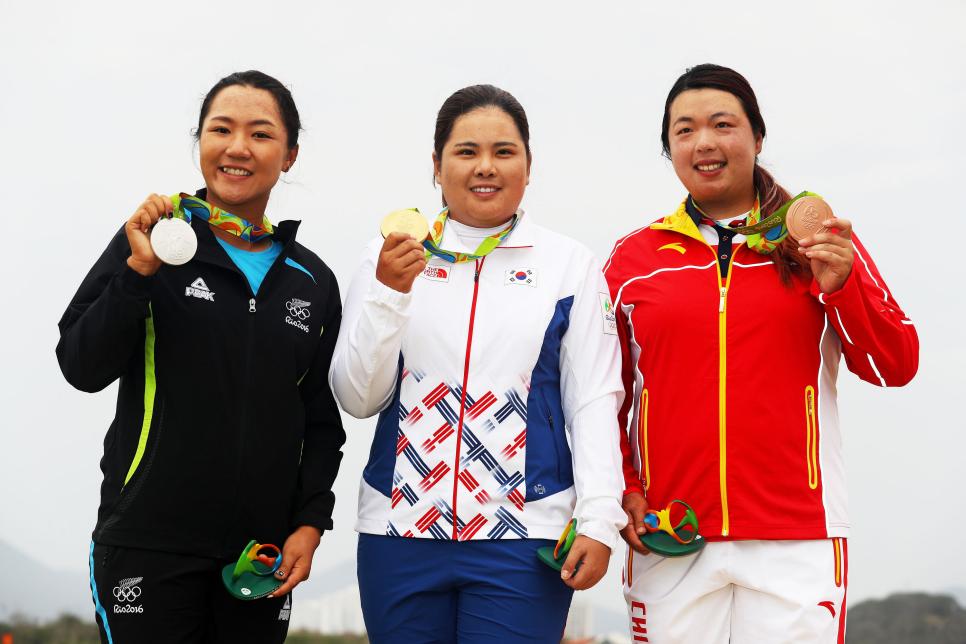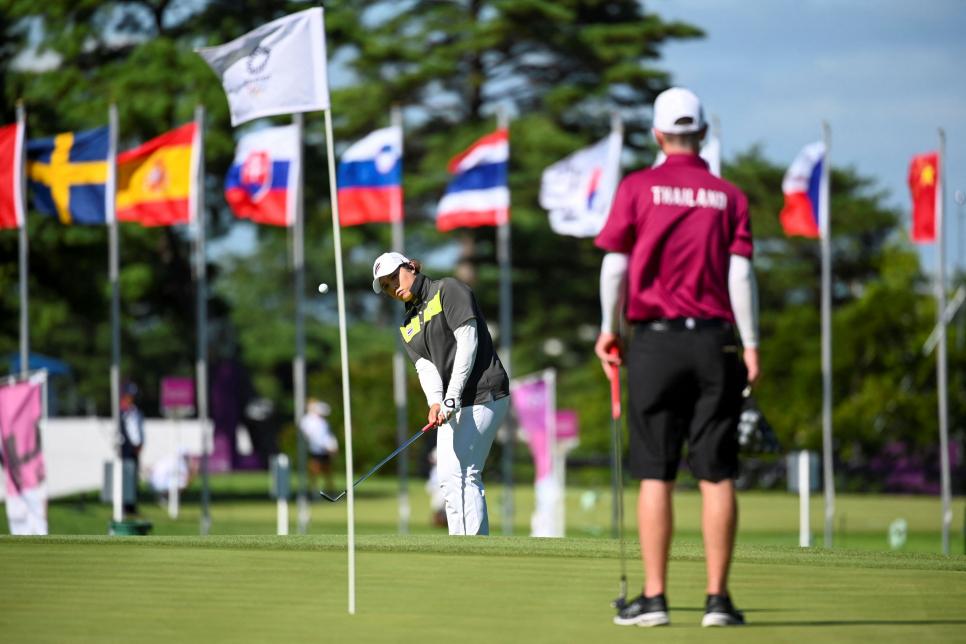Mike Whan became the LPGA Tour commissioner in January 2010, three months after the International Olympic Committee announced golf’s return to the Olympics beginning with Rio in 2016. Part of Whan’s new duties included attending quarterly Olympic board meetings to discuss how golf would fit into the Games, meeting alongside the power brokers of golf: PGA Tour commissioner Tim Finchem, deputy commissioner Jay Monahan, USGA chief executive Mike Davis, European Tour chief executive George O’Grady and R&A chief executive Peter Dawson.
When he first attended the meeting, Whan was sceptical of the value of golf being in the Olympics, at one point sharing with Finchem his concerns. “I said, ‘Tim, was this really necessary?’” Whan explained. “‘I’ve got to rearrange my schedule every four years. There’s plenty of big championships in golf that other sports don’t have.’“Tim said to me, ‘Mike, I struggled with it in the beginning. But I think you’ll find the impact this has around the world will be more than well worth it.’”
Finchem’s foresight proved sharp, and Whan, now running the USGA, has become an Olympics zealot, particularly regarding the women’s game. With the second Olympic women’s golf tournament in the modern era now underway, golf’s inclusion in the Summer Games has been a key part of the LPGA’s expansive growth in the 11 years since the announcement.The tangible byproduct of golf earning full medal status in the Olympics has been investment by countries into the golf’s infrastructure, regardless of whether or not their athletes earn a medal. Governments use financial resources to build programs that help developing players at a young age and provide opportunities to play the sport to help identify rising talent.
RELATED: Five underdog golfers poised for Olympic glory
India’s Aditi Ashok almost single-handedly inspired her country into action during the 2016 Olympics. After shooting back-to-back 68s to sit four off the lead, the then 18-year-old shared her aspirations for the game in her homeland. “Golf becoming an Olympic sport is definitely going to help,” Ashok said. “We are hopefully going to have more golf courses and kids taking up the sport.”
That hope paid off nearly immediately, as more than 20 million people from India searched for golf clubs on Google that evening. Ashok returned to Tokyo with another chance to inspire after almost becoming the first Indian to win on the LPGA at the Dow Great Lakes Bay Invitational in July, finishing T-3 alongside Thailand’s Pajaree Anannarukarn. Ashok opened with a four-under 67 yesterday to sit just a stroke off the lead.
Anannarukarn broke through for her first career victory at last week’s ISPS Handa World Invitational, becoming the fifth player from Thailand to win in LPGA history. The LPGA started playing the Honda LPGA Thailand in 2006. Whan views the road Thailand took to growing the game as a notable example of the success golf has witnessed since becoming a “podium” sport.
“[The LPGA] went from playing in Thailand and generally never seeing women play in Thailand,” Whan explained, “to being televised in Thailand, to having women on the tour from Thailand, to Ariya Jutanguarn [and Patty Tavatanakit] win Majors and be top players in the world from Thailand.” Thailand’s growth is showing brightest in 2021 as the country with the second-most wins of any nation on the LPGA this year (four), trailing only the United States (six).

Reaching the podium can inspire another level of greatness. Inbee Park’s gold medal rated as the second most-watched women’s golf telecast in South Korean history, behind only Se Ri Pak’s breakthrough 1998 US Women’s Open title. When Park won the gold, 23.9 percent of households saw her do it. It’s helped change the culture of the game in South Korea.
“It’s just gotten a lot more people into golf,” Park explained. “When they were usually older, 50 years of age for South Korea, but now it’s everyone’s sport. Because of the Olympics, a lot of people picked up golf, and they really enjoyed playing golf. The variety of the people playing golf is amazing.”
Lydia Ko’s silver medal contributed to her receiving the New Zealand Order of Merit at the end of 2018, one of the nation’s highest civilian honours. Along with her scholarship, given to up and coming golfers, Ko focuses on other opportunities to grow the game in her home country. “If I can inspire one more juniors to take up the game and want to become the next LPGA player or PGA player, I think that’s a job well done on my part,” Ko said.
Shanshan Feng’s bronze medal at the ’16 Olympics coincided with substantial growth in junior golf in China, as the nation grew from 400 junior players in 2013 to 34,572 in 2017.
The LPGA benefits from most Olympians playing on the its tour or on its developmental Symetra Tour. More than 50 countries are represented from the LPGA’s two tours today. “The nice thing about the LPGA is that [fans of women’s golf in the Olympics] can tune in the very next week and see all those same athletes competing, and competing 30 times a year,” said Heather Daly-Donofrio, chief tour operations officer of the LPGA.

The investment into the game and better opportunities for players to emerge out of countries worldwide are one of the most impactful trickle-down benefits the LPGA receives. Whenever a player from a new nation makes it to the LPGA, the tour gets a lucrative call. “From a purely selfish perspective,” Whan said, “every time a country has an athlete make it to the LPGA from their country, that country generally tries to buy our TV rights. Those TV rights are generally what keeps the LPGA going.”Since 2010 the LPGA has gone from broadcasting in 20 countries to more than 175 countries. “That wasn’t just the Olympics but, man, the Olympics sure put wind in the sails,” Whan said.
Another unforeseen benefit from the Olympics was the LPGA’s new North American TV deal, set to begin in 2022. The relationship Monahan and Whan built from their quarterly meetings as they worked on the Olympics was part of the reason the PGA Tour and LPGA negotiated their new TV contracts together. As a result, the PGA Tour is now promoting where the LPGA is playing during its broadcasts, an expensive and important slot to advertise to PGA’s audience.
“If I was honest, some of our international TV deals were pretty lucrative, but we didn’t have a great US TV deal,” Whan said. “Jay helped us get one that’s much more attractive in terms of what it could mean in terms of hours of coverage, but what it could mean financially for the business.”
In those Olympic meetings, more partnerships were formed. The LPGA and LET formed a strategic alliance in 2019, which also included current European Tour and R&A chief executives Keith Pelley and Martin Slumbers joining the LET board. Daly-Donofrio said she was able to tap into communication lines built out of the Olympic meetings to share best practices on navigating the COVID-19 pandemic.
“I can’t tell you how many times a week I will reach out to somebody from the PGA of America or European Tour or the PGA Tour,” Daly-Donofrio said.
As women’s golf continues at Kasumigaseki Country Club with golf on the schedule for Paris in 2024 and Los Angeles in 2028, the LPGA stands to further benefit from the power of the Olympics.
“Golf is more aligned because of the glue that was the Olympic movement,” Whan said.



